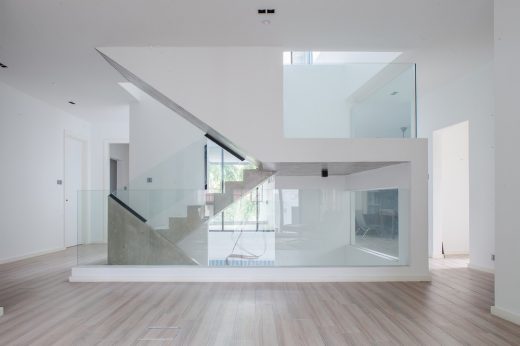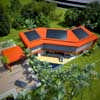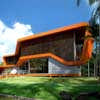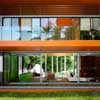Sime Darby Idea House, Malaysian Building Design, Project News, Property Image
Sime Darby Idea House
Residential Development Malaysia, southeast Asia homes design by Broadway Malyan architects
22 Oct 2009
Sime Darby Idea House Design
Design: Broadway Malyan Architects
Sime Darby Idea House News
Introduction
With 80 million barrels of oil consumed on a daily basis (Opec, 2008) and the built environment accounting for 33 % of the world’s carbon emissions (World green building council 2008; US department of energy 2008), it is little surprise that our global society has awoken to the importance of preserving our one world for future generations.
Collectively, governments have been instrumental in helping sustain our natural environment through broader initiatives such as the Kyoto protocol, whilst individually they have sought to establish an increasing plethora of regional environmental rating systems for implementation in the built environment.
The global picture painted is one of a concerted effort in minimising waste and preserving our natural resources. Governments have led by example in the procurement of sustainable public works, particularly in the education, healthcare and civic realm sectors which, by inference and necessity, has seen the private sector follow suit.
Project background – The green consumer
The private sector’s embracing of the sustainability agenda has not just been because of governmental policy and legislation. The needs of the ‘green consumer’, awoken to the ‘Inconvenient truth’ of global warming and the depletion of natural resources, has become an important social classification for which the building industry have needed to address.
The green consumer’s environmental, social and economic consciousness is manifest in the green buildings that they buy or rent. In adopting a more sustainable approach to design, developers are not only satisfying their own corporate social responsibilities in the preservation of the planet, but attracting the green consumer and corporation and increasingly reaping the economic benefits.
Sime Darby Property, Malaysia’s largest property developer; approached us in August 2008 with the brief for ‘The Idea House’ – a socially, economically, and environmentally responsive prototype dwelling that would provide an insight into future tropical living. Conceived as a test bed for new ideas, the house would showcase the latest in sustainable architecture in the buildings’ quest to become the first carbon zero residence in Southeast Asia.
Sime Darby Property would systematically adopt particular strategies in the house in part or in entirety in their housing projects, demonstrating their commitment to furthering the cause of creating sustainable futures for future generations.
Topographic responsiveness
A close interaction between architect, landscape architect, infrastructural and civil engineers allowed for a co-ordinated response to the positioning of the house within the site. Exploiting the raised position on the site affords the Idea House views out over the landscape; will being a highly visible beacon.
The house responds similarly to the contours of the site’s topography. The house is cranked in order to follow such levels, in order to create a contextual response that minimises the adverse effects of cutting and filling of the landscape. This preserves the site as much as possible for future generations.
Building form
A study of the traditional Malay Kampung house was one of the key drivers. The Kampung house, in its socio-environmental responsiveness, provides deep overhangs that permit shade, weather protection and therefore opportunities for social interaction and habitation of the anjung and serambi verandah spaces. Open, permeable flexible interior spaces with higher roof volumes allow for social and spatial flexibility, made comfortable by cross ventilation.
Lifting the building on stilts maximises air flow, provides a clear separation between public and private, and ultimately creates a ‘lightness of touch’ to the ground through minimal groundwork penetrations. Such principles were incorporated into the Idea House, albeit that the building form pays little similarity to its vernacular cousin. Instead, a curvilinear ribbon forms floor, wall and roof in a sinuous fashion, defining space and at the same time creating a highly legible structure.
Landscape
An integrated approach to the landscape was sought that positioned the Idea House as a pavilion within the landscape, in a fashion not too dissimilar to the more rural setting of the Kampung house. As part of the Ideas Park, (a similar showcase for innovation and sustainability by Sime Darby) the design takes a cue from the curvilinear forms of the building as well as the topographical contours of the site. Integration between landscape and building is also established through a landscape scheme that is divided into garden sections that promote health, well being, recreation, healing, agriculture, permaculture and the medicinal.
Grey water and water management
The design plans to capture 50 % of the ‘grey water’ from wash hand basins and showers via a filtration system. The water can then be re-used to flush the WC’s, thus reducing water consumption and therefore utility costs. Water wastage is set to be further minimised by aerating the showers, resulting in less water being consumed by the room occupants. Based on an occupant using 133litres of water per day, the aeration of showers could reduce consumption to 64 litres per day.
Green roof and rainwater catchment
Green roof technology is incorporated into the roof garden, helping reduce storm water run off and thus minimise the loading onto storm water drains. The green roof can also be replaceable. Whilst currently proposed as a roof garden, the space can be converted in the future to a further habitable room. The rainwater captured by the sloping roof would be collected into water storage tanks from which the water harvested would be used for irrigating the vegetation within the development.
Orientation and climatic responsiveness
A ‘back to basics’ approach to the environmental strategy is applied, which is passive and lo-tech. Carefully orientating the building to present the shorter faces to the east and west helps minimise heat gain and therefore lower cooling loads. This is complimented by deep overhangs to provide shade and respite from the sun and tropical showers, all of which help reduce the reliance on mechanical ventilation, cooling systems and its associated costs. Daylight analysis of the narrow plan form demonstrates excellent daylight penetration to the habitable areas, reducing the need for artificial lighting during the day and into early evening.
Harnessing solar energy
The Idea House will include the installation of photovoltaic cell technology on the roof to harness the sun’s rays as a renewable energy source. Such an approach would be subject to governmental grants to offset the costs of such technology in the increasing interests of promoting sustainable energy sources in Malaysia.
Given the cumulative roof area designated for photovoltaic cells, it is anticipated the area provided will generate enough energy to sustain a family of five. It is intended to replace the photovoltaic cell technology after a period of time in order to gauge the relative merits between mono-crystalline, poly-crystalline, and membrane types of Photovoltaic cell.
Natural ventilation
The open plan nature of the house, coupled with the ability for the external and internal walls to be slid back to remove any physical internal external barrier, capitalises on its ability to be cross ventilated. Orientating the living spaces in a south westerly direction allows for the harnessing of the prevailing SW wind that takes place 80% of the year and therefore reduces the need for artificial methods of ventilation and air flow. Internal temperature and humidity levels were also lowered, with the wind velocity of 1m/s within building being more than the 0.6m/s required by Green Mark.
Expansion and contraction
An understanding of the needs of the Malaysian demographic, coupled with due respect of the expansion and contraction of the family nucleus, finds its expression in the Idea House as a fully adaptable dwelling. Void spaces can be filled to create further living or sleeping spaces as the family expands, or can be removed in the future as the children grow up and leave home. Open plan living allows for a more flexible lifestyle, promoting internal / external adaptation of spaces to be changed to suit the families live / work / play requirements.
Modularisation and ease of construction
Modern methods of construction that includes prefabrication and modularisation will reduce the reliance on specialist labour; wet trades, and provides opportunities to employ individuals with a lower skills base. The modular construction also enables a speedier construction process, saving time and therefore financial / resource burden.
As the entire frame and construction would be modular to provide not only a speed and ease of construction, it also provides the ability for the development, if necessary, to be demounted in the future in order to preserve the terrain for future generations and / or future development.
Multi disciplinary collaboration
Right from the outset, the approach to the brief demonstrated the importance of collaboration – giving due recognition to the concept that a sustainable product can only be truly created if there is a sustainable process in place. A multi-disciplinary interface between architects, engineers, landscape designers, urbanists, contractors and suppliers minimised the project programme by 50% when compared with the generic residential model.
In order to achieve this, the team’s common understanding that 1) the Idea House would become a benchmark in sustainable residential design and act as a precedent for Malaysian lifestyle living and 2) that such a position would only be attainable through pro-active knowledge sharing either via workshops and BIM models was therefore fundamental.
Jason Pomeroy – Director of Singapore
Oct 2009
Sime Darby Idea House images / information from Broadway Malyan 221009
Location: Malaysia, Southeast Asia
Malaysia Buildings
Contemporary Malaysian Architecture
Malaysian Architecture Designs – chronological list
National Heart Centre, Singapore by Broadway Malyan
National Heart Centre Singapore
Bird Island Zero-Energy Home by Zoka Zola Architecture + Urban Design
3×3 House, Kuala Lumpur
Design: CL3 Architects Limited, openUU Limited, Lim + Lu Design Limited

photograph : Nirut Benjabanpot
3×3 House in Kuala Lumpur
The Troika Kuala Lumpur by Foster + Partners
Kuala Lumpur development : Putrajaya Waterfront
Malaysian University of Technology by Foster + Partners
Malaysian Skyscraper : Penang Global City Center
Singapore Architecture Designs
Singapore Tower by OMA
Comments / photos for the Sime Darby Idea House Malaysia Architecture page welcome
Website: Visit Malaysia




